Abstract
In a previous study we have shown that cultured epithelial cell lines can be used to measure the transepithelial passage of antimicrobial agents across the intestine and to obtain information on the mechanisms of transport utilized and predict the bioavailability of the antimicrobial agents after oral administration. In particular, among the drugs investigated, D-cycloserine had been shown to be transported in a polarized manner only in the intestinal cells. In the present work, further characterization of the transport of D-cycloserine in the human intestinal cell line Caco 2 has shown that this occurs in the apical-to-basolateral direction by an active mechanism which is energy dependent but only partially sodium dependent. Competition studies have also indicated that the transport of D-cycloserine occurs via a carrier for imino acids, amino acids with aliphatic side chains (L-Ala, D-Ala, and beta Ala), and L-Trp, L-Tyr, L-Cys, and alpha-amino isobutyric acid. This system may correspond to a proton-dependent system for L-proline and beta-alanine recently described for Caco 2 cells. In contrast with the cephalosporins, which are taken up by the Caco 2 cells via a dipeptide carrier, D-cycloserine transport cannot be inhibited by either cephalexin (a member of the class of cephalosporins) or dipeptides.
Full text
PDF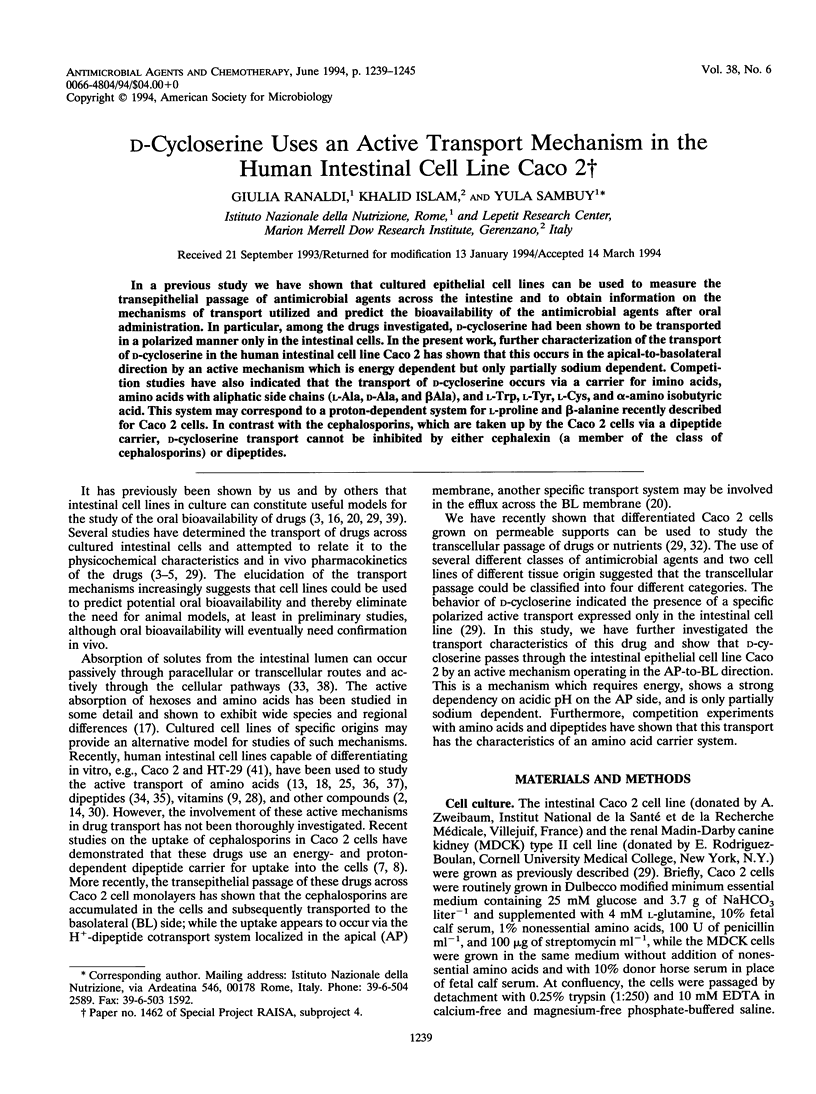
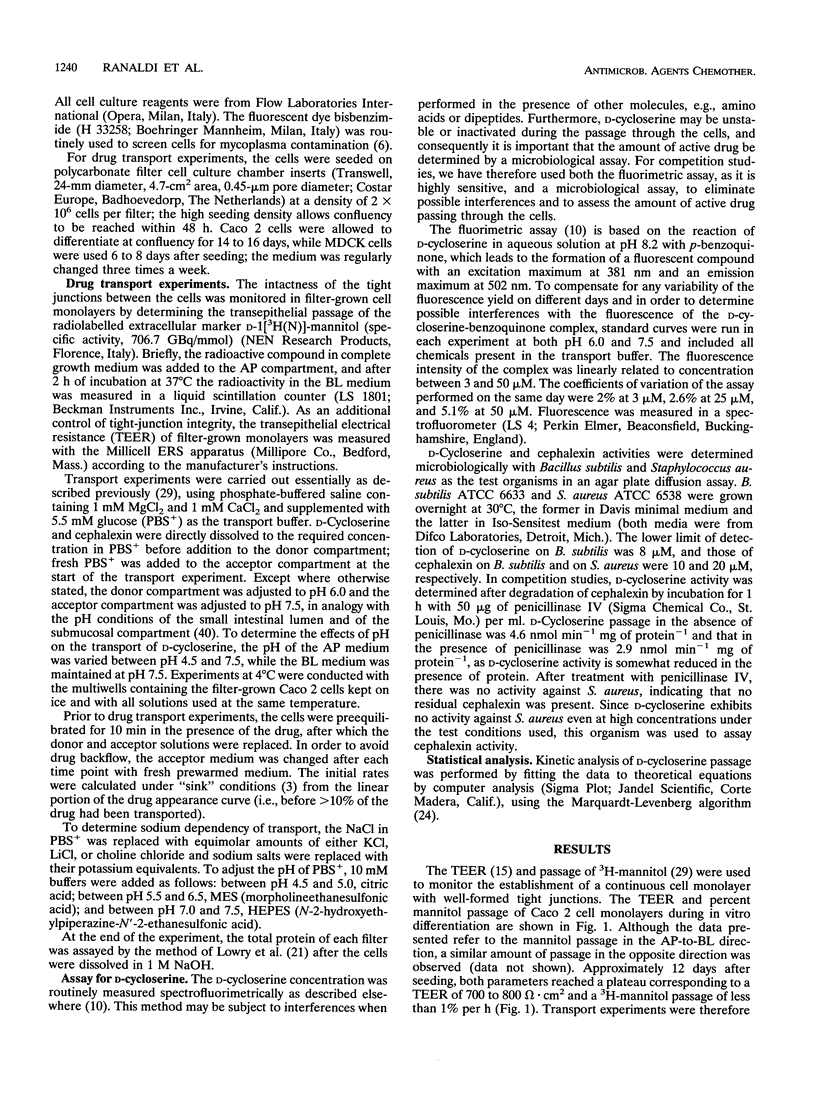
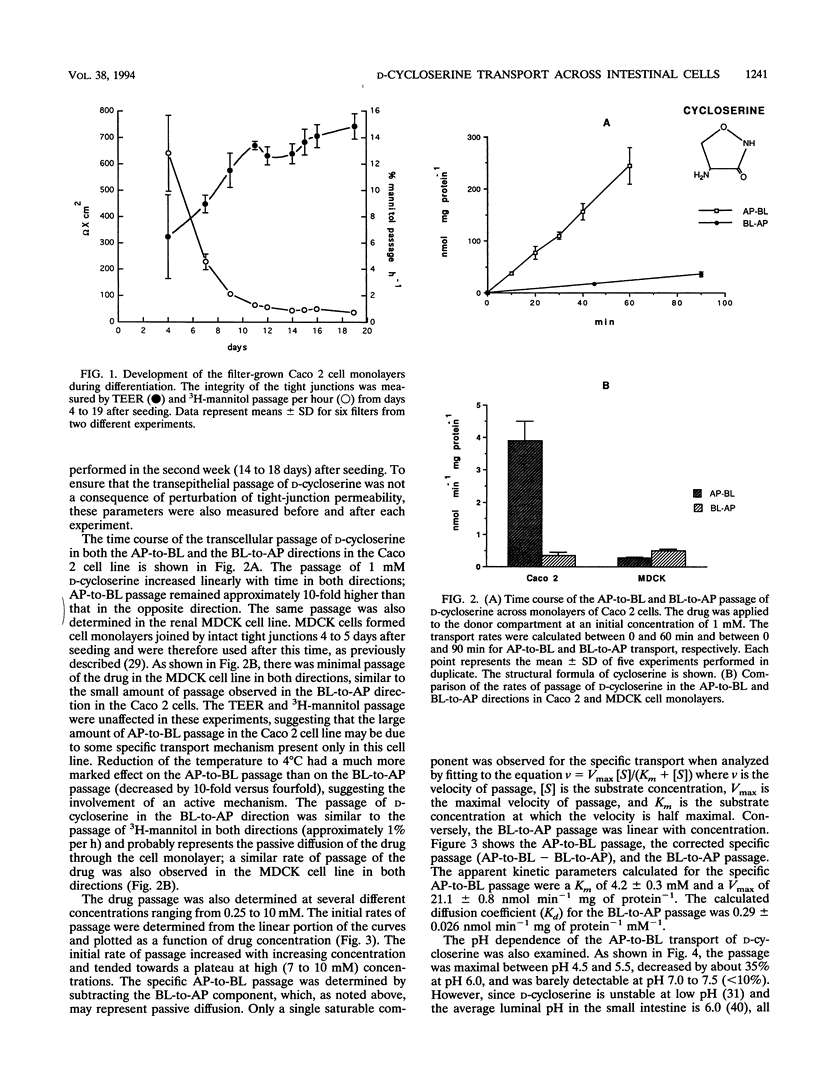
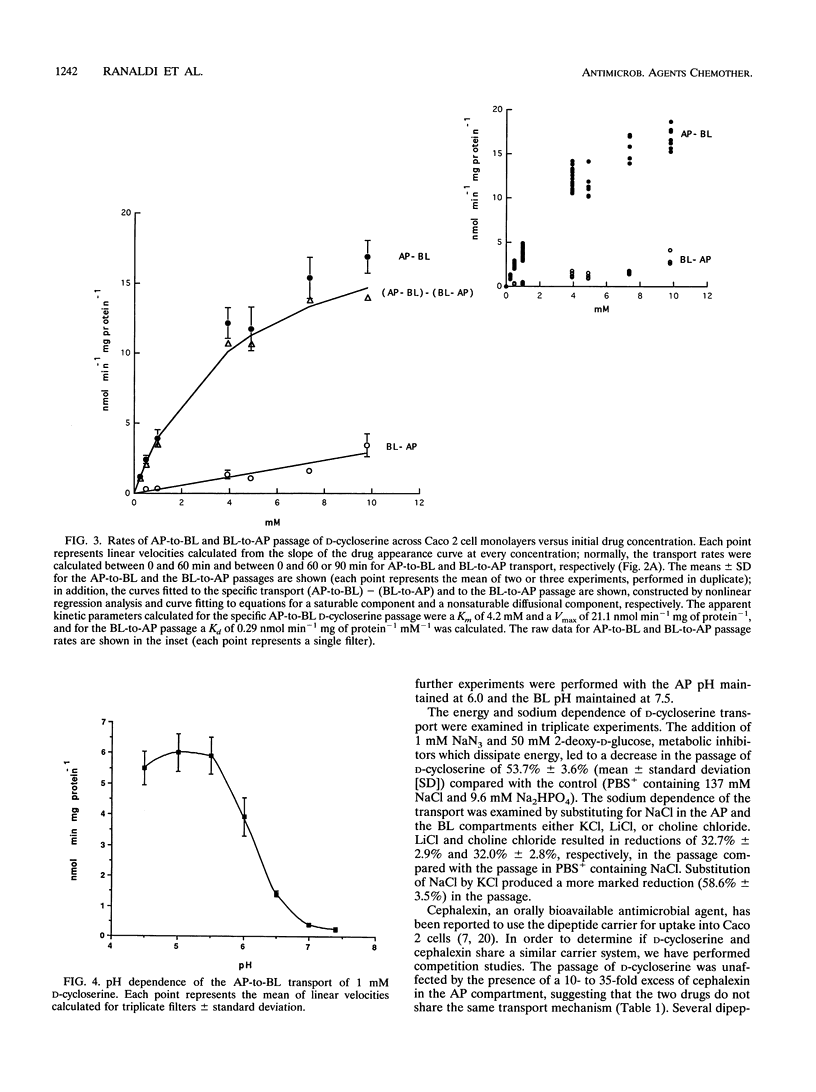
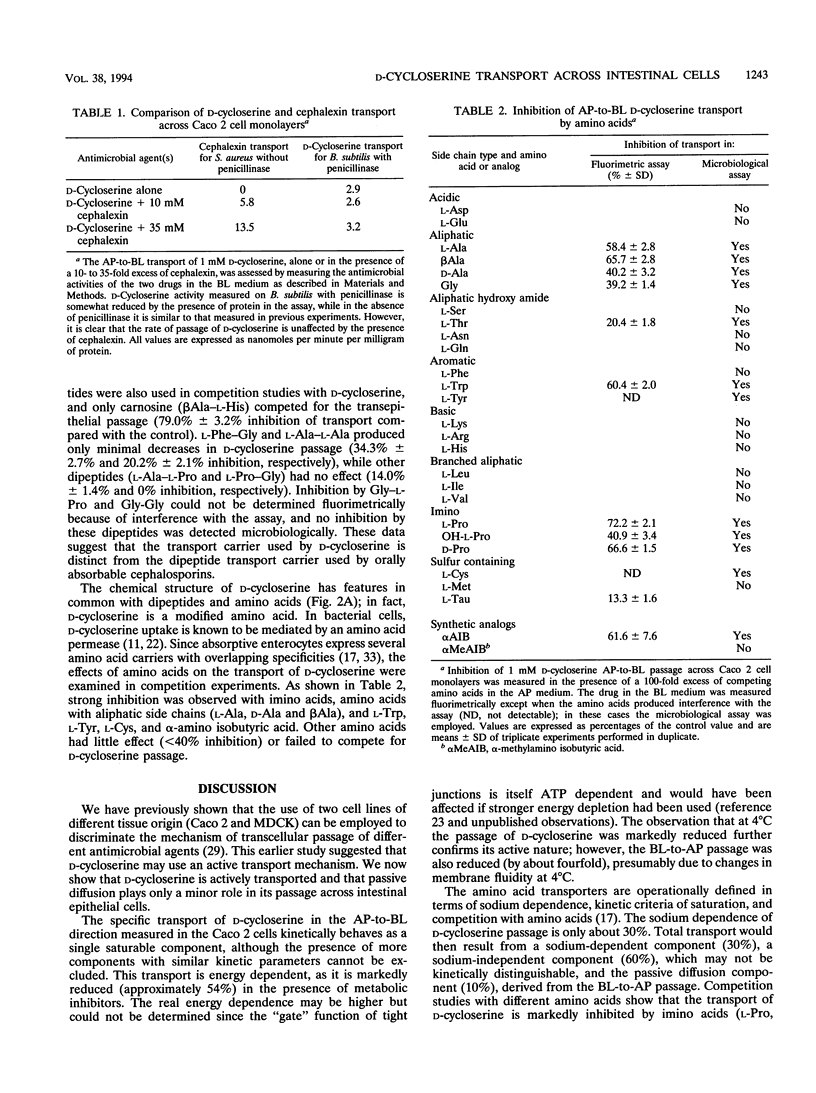
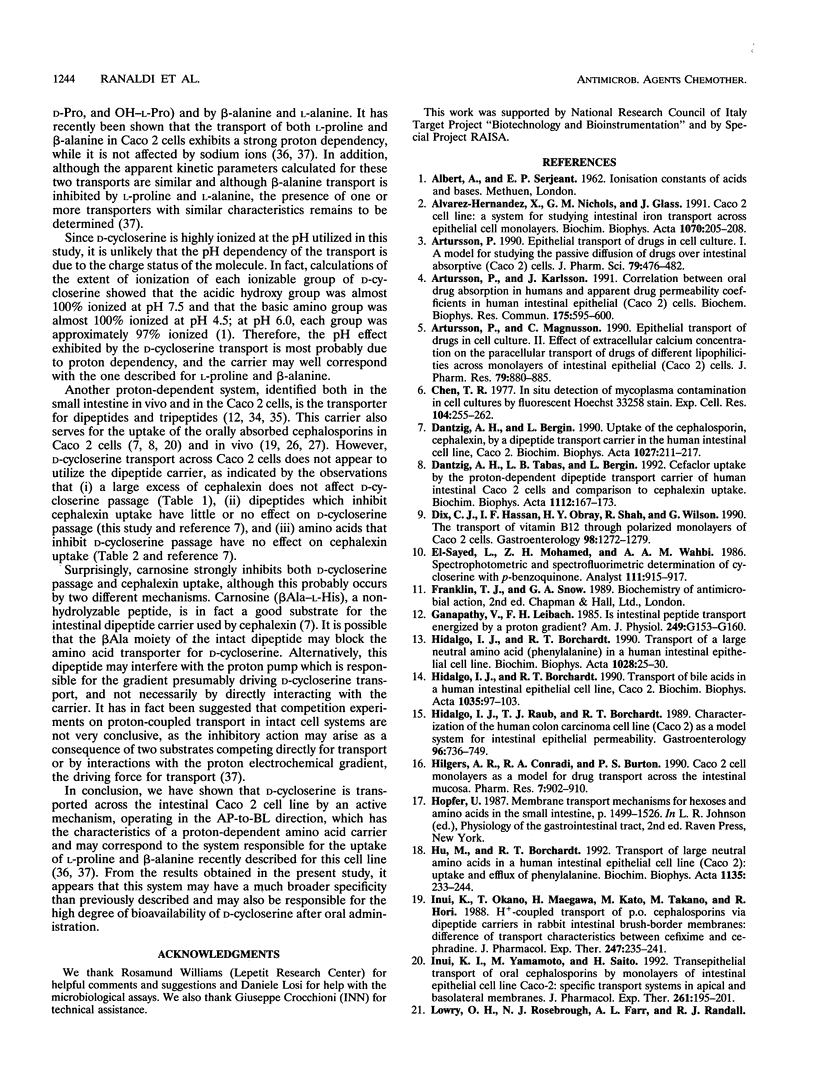
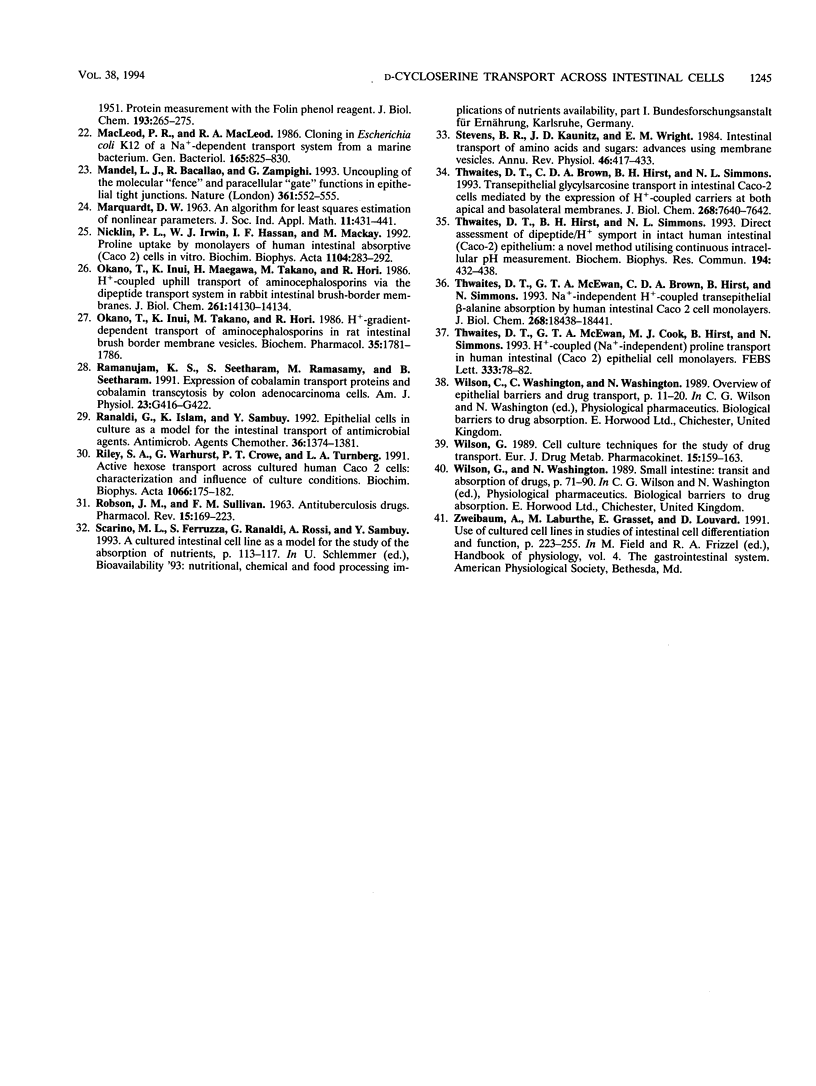
Selected References
These references are in PubMed. This may not be the complete list of references from this article.
- Alvarez-Hernandez X., Nichols G. M., Glass J. Caco-2 cell line: a system for studying intestinal iron transport across epithelial cell monolayers. Biochim Biophys Acta. 1991 Nov 18;1070(1):205–208. doi: 10.1016/0005-2736(91)90165-5. [DOI] [PubMed] [Google Scholar]
- Artursson P. Epithelial transport of drugs in cell culture. I: A model for studying the passive diffusion of drugs over intestinal absorptive (Caco-2) cells. J Pharm Sci. 1990 Jun;79(6):476–482. doi: 10.1002/jps.2600790604. [DOI] [PubMed] [Google Scholar]
- Chen T. R. In situ detection of mycoplasma contamination in cell cultures by fluorescent Hoechst 33258 stain. Exp Cell Res. 1977 Feb;104(2):255–262. doi: 10.1016/0014-4827(77)90089-1. [DOI] [PubMed] [Google Scholar]
- Dantzig A. H., Bergin L. Uptake of the cephalosporin, cephalexin, by a dipeptide transport carrier in the human intestinal cell line, Caco-2. Biochim Biophys Acta. 1990 Sep 7;1027(3):211–217. doi: 10.1016/0005-2736(90)90309-c. [DOI] [PubMed] [Google Scholar]
- Dantzig A. H., Tabas L. B., Bergin L. Cefaclor uptake by the proton-dependent dipeptide transport carrier of human intestinal Caco-2 cells and comparison to cephalexin uptake. Biochim Biophys Acta. 1992 Dec 9;1112(2):167–173. doi: 10.1016/0005-2736(92)90388-3. [DOI] [PubMed] [Google Scholar]
- Dix C. J., Hassan I. F., Obray H. Y., Shah R., Wilson G. The transport of vitamin B12 through polarized monolayers of Caco-2 cells. Gastroenterology. 1990 May;98(5 Pt 1):1272–1279. doi: 10.1016/0016-5085(90)90344-z. [DOI] [PubMed] [Google Scholar]
- Ganapathy, Leibach F. H. Is intestinal peptide transport energized by a proton gradient? Am J Physiol. 1985 Aug;249(2 Pt 1):G153–G160. doi: 10.1152/ajpgi.1985.249.2.G153. [DOI] [PubMed] [Google Scholar]
- Hidalgo I. J., Borchardt R. T. Transport of a large neutral amino acid (phenylalanine) in a human intestinal epithelial cell line: Caco-2. Biochim Biophys Acta. 1990 Sep 21;1028(1):25–30. doi: 10.1016/0005-2736(90)90261-l. [DOI] [PubMed] [Google Scholar]
- Hidalgo I. J., Borchardt R. T. Transport of bile acids in a human intestinal epithelial cell line, Caco-2. Biochim Biophys Acta. 1990 Jul 20;1035(1):97–103. doi: 10.1016/0304-4165(90)90179-z. [DOI] [PubMed] [Google Scholar]
- Hidalgo I. J., Raub T. J., Borchardt R. T. Characterization of the human colon carcinoma cell line (Caco-2) as a model system for intestinal epithelial permeability. Gastroenterology. 1989 Mar;96(3):736–749. [PubMed] [Google Scholar]
- Hilgers A. R., Conradi R. A., Burton P. S. Caco-2 cell monolayers as a model for drug transport across the intestinal mucosa. Pharm Res. 1990 Sep;7(9):902–910. doi: 10.1023/a:1015937605100. [DOI] [PubMed] [Google Scholar]
- Hu M., Borchardt R. T. Transport of a large neutral amino acid in a human intestinal epithelial cell line (Caco-2): uptake and efflux of phenylalanine. Biochim Biophys Acta. 1992 Jun 29;1135(3):233–244. doi: 10.1016/0167-4889(92)90226-2. [DOI] [PubMed] [Google Scholar]
- Inui K., Okano T., Maegawa H., Kato M., Takano M., Hori R. H+ coupled transport of p.o. cephalosporins via dipeptide carriers in rabbit intestinal brush-border membranes: difference of transport characteristics between cefixime and cephradine. J Pharmacol Exp Ther. 1988 Oct;247(1):235–241. [PubMed] [Google Scholar]
- Inui K., Yamamoto M., Saito H. Transepithelial transport of oral cephalosporins by monolayers of intestinal epithelial cell line Caco-2: specific transport systems in apical and basolateral membranes. J Pharmacol Exp Ther. 1992 Apr;261(1):195–201. [PubMed] [Google Scholar]
- MacLeod P. R., MacLeod R. A. Cloning in Escherichia coli K-12 of a Na+-dependent transport system from a marine bacterium. J Bacteriol. 1986 Mar;165(3):825–830. doi: 10.1128/jb.165.3.825-830.1986. [DOI] [PMC free article] [PubMed] [Google Scholar]
- Mandel L. J., Bacallao R., Zampighi G. Uncoupling of the molecular 'fence' and paracellular 'gate' functions in epithelial tight junctions. Nature. 1993 Feb 11;361(6412):552–555. doi: 10.1038/361552a0. [DOI] [PubMed] [Google Scholar]
- Nicklin P. L., Irwin W. J., Hassan I. F., Mackay M. Proline uptake by monolayers of human intestinal absorptive (Caco-2) cells in vitro. Biochim Biophys Acta. 1992 Mar 2;1104(2):283–292. doi: 10.1016/0005-2736(92)90042-k. [DOI] [PubMed] [Google Scholar]
- Okano T., Inui K., Maegawa H., Takano M., Hori R. H+ coupled uphill transport of aminocephalosporins via the dipeptide transport system in rabbit intestinal brush-border membranes. J Biol Chem. 1986 Oct 25;261(30):14130–14134. [PubMed] [Google Scholar]
- Okano T., Inui K., Takano M., Hori R. H+ gradient-dependent transport of aminocephalosporins in rat intestinal brush-border membrane vesicles. Role of dipeptide transport system. Biochem Pharmacol. 1986 Jun 1;35(11):1781–1786. doi: 10.1016/0006-2952(86)90292-3. [DOI] [PubMed] [Google Scholar]
- ROBSON J. M., SULLIVAN F. M. Antituberculosis drugs. Pharmacol Rev. 1963 Jun;15:169–223. [PubMed] [Google Scholar]
- Ramanujam K. S., Seetharam S., Ramasamy M., Seetharam B. Expression of cobalamin transport proteins and cobalamin transcytosis by colon adenocarcinoma cells. Am J Physiol. 1991 Mar;260(3 Pt 1):G416–G422. doi: 10.1152/ajpgi.1991.260.3.G416. [DOI] [PubMed] [Google Scholar]
- Ranaldi G., Islam K., Sambuy Y. Epithelial cells in culture as a model for the intestinal transport of antimicrobial agents. Antimicrob Agents Chemother. 1992 Jul;36(7):1374–1381. doi: 10.1128/aac.36.7.1374. [DOI] [PMC free article] [PubMed] [Google Scholar]
- Riley S. A., Warhurst G., Crowe P. T., Turnberg L. A. Active hexose transport across cultured human Caco-2 cells: characterisation and influence of culture conditions. Biochim Biophys Acta. 1991 Jul 22;1066(2):175–182. doi: 10.1016/0005-2736(91)90184-a. [DOI] [PubMed] [Google Scholar]
- Stevens B. R., Kaunitz J. D., Wright E. M. Intestinal transport of amino acids and sugars: advances using membrane vesicles. Annu Rev Physiol. 1984;46:417–433. doi: 10.1146/annurev.ph.46.030184.002221. [DOI] [PubMed] [Google Scholar]
- Thwaites D. T., Brown C. D., Hirst B. H., Simmons N. L. Transepithelial glycylsarcosine transport in intestinal Caco-2 cells mediated by expression of H(+)-coupled carriers at both apical and basal membranes. J Biol Chem. 1993 Apr 15;268(11):7640–7642. [PubMed] [Google Scholar]
- Thwaites D. T., Hirst B. H., Simmons N. L. Direct assessment of dipeptide/H+ symport in intact human intestinal (Caco-2) epithelium: a novel method utilising continuous intracellular pH measurement. Biochem Biophys Res Commun. 1993 Jul 15;194(1):432–438. doi: 10.1006/bbrc.1993.1838. [DOI] [PubMed] [Google Scholar]
- Thwaites D. T., McEwan G. T., Brown C. D., Hirst B. H., Simmons N. L. Na(+)-independent, H(+)-coupled transepithelial beta-alanine absorption by human intestinal Caco-2 cell monolayers. J Biol Chem. 1993 Sep 5;268(25):18438–18441. [PubMed] [Google Scholar]
- Thwaites D. T., McEwan G. T., Cook M. J., Hirst B. H., Simmons N. L. H(+)-coupled (Na(+)-independent) proline transport in human intestinal (Caco-2) epithelial cell monolayers. FEBS Lett. 1993 Oct 25;333(1-2):78–82. doi: 10.1016/0014-5793(93)80378-8. [DOI] [PubMed] [Google Scholar]
- Wilson G. Cell culture techniques for the study of drug transport. Eur J Drug Metab Pharmacokinet. 1990 Apr-Jun;15(2):159–163. doi: 10.1007/BF03190199. [DOI] [PubMed] [Google Scholar]
- el-Sayed L., Mohamed Z. H., Wahbi A. A. Spectrophotometric and spectrofluorimetric determination of cycloserine with p-benzoquinone. Analyst. 1986 Aug;111(8):915–917. doi: 10.1039/an9861100915. [DOI] [PubMed] [Google Scholar]


